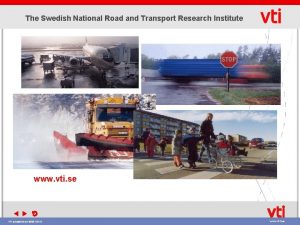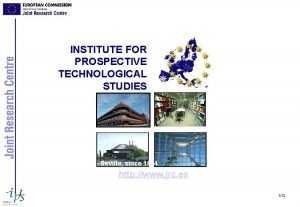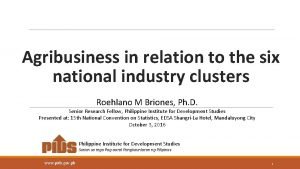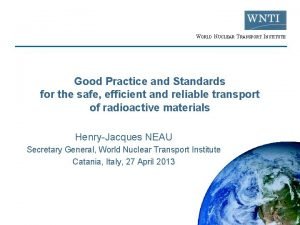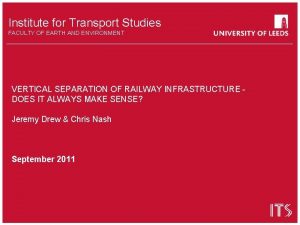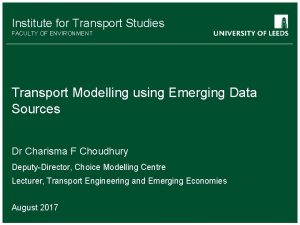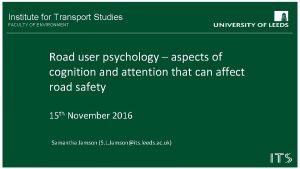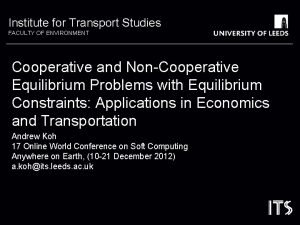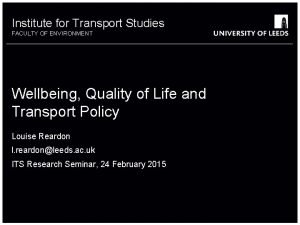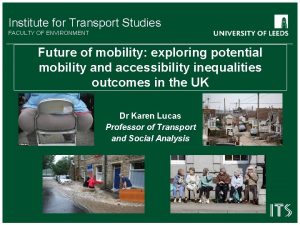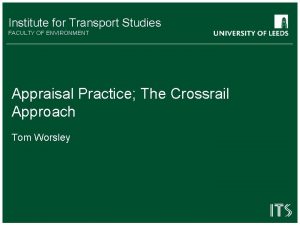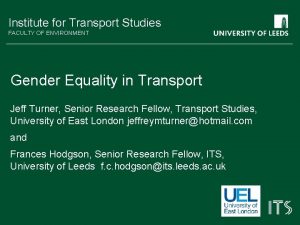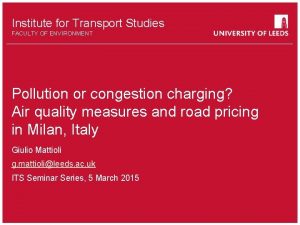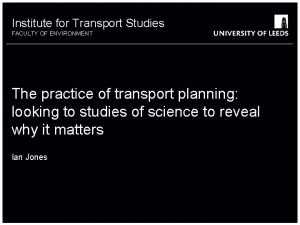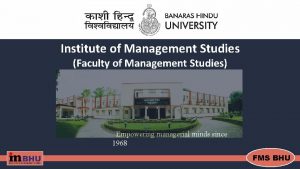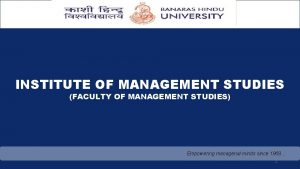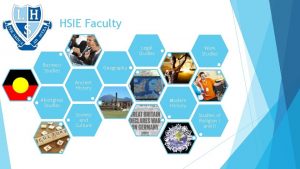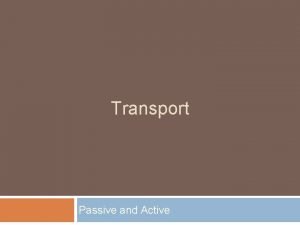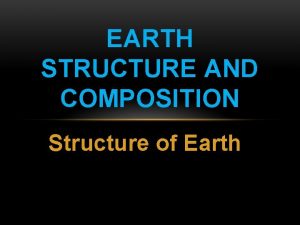Institute for Transport Studies FACULTY OF EARTH AND






























- Slides: 30

Institute for Transport Studies FACULTY OF EARTH AND ENVIRONMENT When to invest in High Speed Rail Chris Nash C. A. Nash@its. leeds. ac. uk

Outline • Motivation behind high speed rail investment • Costs and benefits of high speed rail • Examples of appraisals – ex ante and ex post • What alternatives should be considered? • Conclusions

Origins (new lines 250 km per hour or more) 1964 Tokaido Line 1981 Paris-Lyon 1981 Rome-Florence (1 st section) 1988 Fulda-Wurzberg 1992 Madrid-Seville 2013 European total 7378 km (Spain 2515; France 2036) World 21472 km (China 9867; Japan 2664) Source: UIC

Motivation for HSR • Speed • Capacity • Reliability • Economic Development • Environment • Supply industries • Prestige • Political integration

Costs and Benefits COSTS • Capital costs • Net Operating costs • Net External costs (environment, safety) • Loss of tax revenue BENEFITS • Revenue • Time savings and improved reliability • Additional capacity; reduced crowding and diversion from other modes • Diversion from other modes (reducing congestion and environmental impact) • Generated traffic • Wider economic benefits

Typical costs of HSR in Europe (m 2004 euros) Capital costs Infrastructure Construction (per km) 12 -40 Construction costs vary enormously with the terrain (especially length of tunnels) and the degree to which new lines and stations in cigties are needed. Operating costs depend mainly on rolling stock requirements, staff, energy, wear and tear – note very high utilisation of assets may offset high energy and maintenance costs

Time savings • Most of the benefits time or time related (crowding, reliability) • Most of them relate to business travel • Usually based on cost savings approach (wage rate plus overheads) • New work based on willingness to pay puts values up! - Can fit more meetings into a day - Avoids travel in (very) unsocial hours

Values of Time for rail 2010 prices Source: Df. T (2015) travellers Current Recommended commuting 6. 81 10. 01 other leisure 6. 04 4. 57 Business 31. 96 36. 19 (>100 km) per hour

Capacity benefits • Increased traffic on hsr route • Increased traffic on other routes • Reduced overcrowding • Improved reliability

Benefits of diversion from car or air • Reduced congestion • Environmental pollution • Accidents • Release of airport capacity for long distance flights

Generated traffic (valued at half the benefits to existing traffic) • Leisure • Commuting • Business Does this reflect relocation of business or net expansion?

Wider economic impacts Current evidence relates mainly to major conurbations - Agglomeration benefits - Labour market benefits - Imperfect competition Are there also benefits from improving inter city connections? Venables, Overman and Laird – specialisation and economies of scale KPMG – correlation between productivity and rail connectivity, but does this imply causation? Should a LUTI model be developed to examine locational implications and further agglomeration?

Ex post appraisal of French high speed line construction Sud Est Atlantique Passengers in first year (m) Social return (%) Nord 15. 8 26. 7 19. 2 Inter Connection 16. 6 30 12 5 13. 8 Source: Conseil Général des Pont et Chaussées (2006) Annex 1 Updated from Crozet (2013) Alpes 18. 6 Meditar ranean 19. 2 10. 6 8. 1

CBA of Madrid-Seville high-speed rail in Spain (billions of 2010 euros) COSTS 6. 8 BENEFITS 4. 5 Of which Time savings 1. 6 Generated traffic 0. 8 Costs saved on other modes 1. 9 External costs saved 0. 2 Net present value of HST -2. 3 Demand in 1993 2. 8 m trips

CBA of Madrid-Barcelona high-speed rail in Spain (billions of 2010 euros) COSTS 12. 4 BENEFITS 7. 2 Of which Time savings 2. 8 Generated traffic 1. 1 Costs saved on other modes 2. 9 External costs saved 0. 4 Net present value of HSR -5. 3 Demand in 2009 5. 5 m trips

First year demand required for breakeven (α = 0. 2 θ = 3%)

s. H 2 HS 2 w? HS 2 New high speed line from London to Birmingham, Manchester and Leeds (with trains running on to Newcastle, Glasgow ands Edinburgh) Objectives • to provide sufficient capacity to meet long term demand, and to improve resilience and reliability across the network; and • to improve connectivity by delivering better journey times and making travel easier. • Economic regeneration and reducing the North-South divide • Reducing greenhouse gases

CBA of HS 2 (£m PV) Phase One Transport benefits (Business) Transport benefits (Other) Other quantifiable benefits Indirect taxes (loss to Govt) Net transport benefits Wider economic impacts Total costs Revenues Net cost to Government Benefit cost ratio (inc WEIs) Oct 2013 16, 921 Full Network Oct 2013 40, 529 7, 673 19, 323 407 788 -1, 208 -2, 912 23, 793 4, 341 29, 919 13, 243 16, 676 1. 7 57, 727 13, 293 62, 606 31, 111 31, 495 2. 3

Long run trend in rail passenger traffic in Great Britain

Forecasting demand 1. Will long run trend favouring rail continue? 2. Impact of improvements in telecommunications 3. Autonomous cars 4. Range of scenarios

Examples of Network Rail forecast growth over 30 years London to: Birmingham 33 -87% Manchester 52 -158% Leeds 46 -123% Birmingham to Manchester 39 -117% Leeds 40 -126%

Diversion from other modes HS 2 patronage is forecast to be: 69% diverted from conventional rail 26% induced 4% from car 1% from air But released capacity on conventional lines may permit more diversion including freight from road.

Current government pricing policy • Rail fares rise by 1% per annum from 2020 (25% by 2036) • HSR fares to be same as conventional rail • But the only sensible pricing policy for HSR is yield management • Threat of open access competition • Motoring costs fall by 40% by 2036 • Air fares fall by 30% by 2036. Should alternative pricing policies be explored? Are they really a matter of overall land use transport strategy

Range of options considered First British domestic HSR study – Atkins 2002 Options considered: - Different routes - New conventional line - Timing - Pricing - Road and air investment

The Atkins study in Britain- results Figure 1. 1

HS 2 alternatives examined • Alternative routes • Longer trains • Upgrading of existing lines • 51 M proposals But not Is infrastructure suitable for 400 km (and actual 360 kmph running) needed?

Incremental benefits and costs compared with 51 M proposal 51 M incremental costs and benefits of HS 2 Benefits 7. 108 46 -52 Costs to gov 1. 173 25 -23 BCR 6. 06 1. 6 -2. 3 Source: derived from Atkins (2012)

Lower speed options • HS 2 Conventional line 9% cheaper • Atkins 2002 Conventional line 15% cheaper But loses 42% of the benefits • Civity 250 -280 vs 300 km plus Capital cost 6. 3% less Operating cost 2. 8% less Benefits 15% less

Conclusions HSR only justified when volumes high (construction cost also crucial) Typically needs around 10 m passengers per annum density on social cost benefit terms (much higher for commercial viability) Level of time savings also critical Should always compare with a range of options including: - Revised pricing ; policy to damp down demand - Upgrading existing lines - Building a new line for conventional speeds

Reference • Christopher Nash (2013) When to Invest in High-Speed Rail. International Transport Forum Discussion Paper No 2013 -25 December. OECD, Paris. • http: //www. internationaltransportforum. org/jtrc/Discussion. P apers/jtrcpapers. html
 Herszon kherson maritime college of merchant marine fleet
Herszon kherson maritime college of merchant marine fleet Sodium potasium pump
Sodium potasium pump Primary active transport and secondary active transport
Primary active transport and secondary active transport Active transport and passive transport
Active transport and passive transport Swedish national road and transport research institute
Swedish national road and transport research institute Paradigm shift from women studies to gender studies
Paradigm shift from women studies to gender studies Now answer the following questions
Now answer the following questions Active transport vs passive transport venn diagram
Active transport vs passive transport venn diagram Pinocytosis vs phagocytosis
Pinocytosis vs phagocytosis Primary active transport vs secondary active transport
Primary active transport vs secondary active transport Bioflix activity membrane transport active transport
Bioflix activity membrane transport active transport Selectively permeable definition biology
Selectively permeable definition biology Institute for prospective technological studies
Institute for prospective technological studies Philippine institute for development studies
Philippine institute for development studies World nuclear transport institute
World nuclear transport institute Kontinuitetshantering
Kontinuitetshantering Typiska drag för en novell
Typiska drag för en novell Nationell inriktning för artificiell intelligens
Nationell inriktning för artificiell intelligens Vad står k.r.å.k.a.n för
Vad står k.r.å.k.a.n för Shingelfrisyren
Shingelfrisyren En lathund för arbete med kontinuitetshantering
En lathund för arbete med kontinuitetshantering Adressändring ideell förening
Adressändring ideell förening Tidbok
Tidbok A gastrica
A gastrica Förklara densitet för barn
Förklara densitet för barn Datorkunskap för nybörjare
Datorkunskap för nybörjare Boverket ka
Boverket ka Debattartikel struktur
Debattartikel struktur Autokratiskt ledarskap
Autokratiskt ledarskap Nyckelkompetenser för livslångt lärande
Nyckelkompetenser för livslångt lärande Påbyggnader för flakfordon
Påbyggnader för flakfordon




